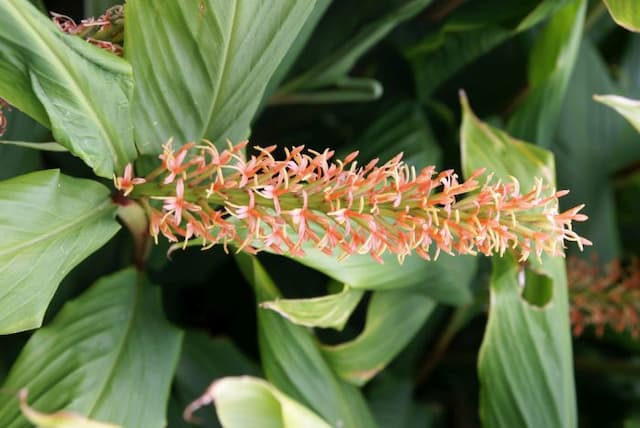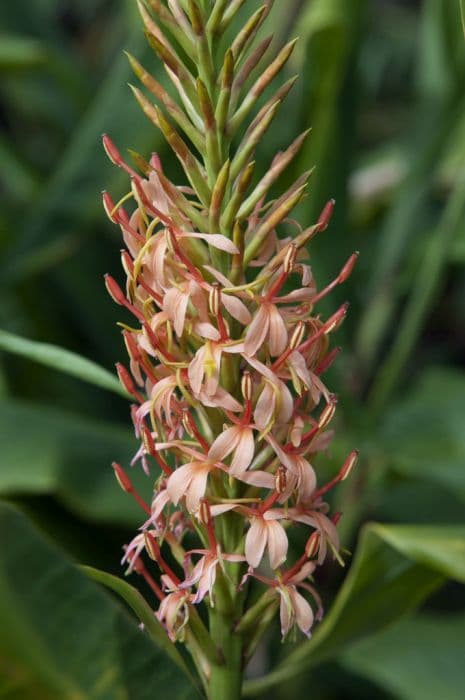Roscoea Roscoea 'Kew Beauty'

ABOUT
Roscoea 'Kew Beauty' is a perennial plant known for its exotic and attractive appearance. This plant flaunts lance-shaped, lush green leaves that create an elegant backdrop for the stunning flowers it produces. The blossoms are remarkable, usually seen in a beautiful shade of purple or lavender that can occasionally have paler or white accents contributing to their delicate charm. The flowers resemble orchids in shape, with a prominent lower lip that provides a landing pad for pollinating insects. The blooms are arranged in a spike-like formation rising from the foliage, giving the impression of a carefully constructed floral arrangement. The intricate, showy flowers, combined with the dense foliage, make Roscoea 'Kew Beauty' a favorite among garden enthusiasts seeking to add a touch of the exotic to their plant collections. The aesthetic appeal of this plant lies in its orchid-like blossoms and the serene grace with which it enhances garden spaces.
About this plant
 Names
NamesFamily
Zingiberaceae
Synonyms
Kew Beauty Roscoea, Ginger Family Jewel
Common names
Roscoea 'Kew Beauty'.
 Toxicity
ToxicityTo humans
The Roscoea 'Kew Beauty', commonly known as Roscoea, does not have a widespread reputation for being poisonous to humans. There is limited information available on its toxicity, suggesting that it is not commonly associated with human poisoning. However, as with any plant not typically consumed as food, it is generally advisable to avoid ingestion. If you suspect poisoning, it's important to consult a medical professional.
To pets
The Roscoea 'Kew Beauty', commonly known as Roscoea, is not well known for being toxic to pets. There is little information available indicating that this plant poses a toxicity risk to animals. However, as with many ornamental plants, prudent caution should be exercised, and pets should not be allowed to eat this or any unknown plants. If you suspect your pet has ingested the plant and is showing signs of illness, consult your veterinarian.
 Characteristics
CharacteristicsLife cycle
Perennials
Foliage type
Deciduous
Color of leaves
Green
Flower color
Purple
Height
1-2 feet (30-60 cm)
Spread
0.5-1 feet (15-30 cm)
Plant type
Herb
Hardiness zones
6
Native area
Asia
Benefits
 General Benefits
General Benefits- Aesthetic Appeal: Roscoea 'Kew Beauty' offers attractive purple flowers that add color and visual interest to gardens.
- Easy to Grow: It is considered easy to care for and can be maintained with minimal effort, making it suitable for gardeners of all skill levels.
- Drought Tolerance: Once established, it has a degree of drought tolerance, which can be beneficial in drier climates or for water-wise gardening.
- Pollinator Friendly: The flowers are known to attract pollinators such as bees, which can help in the pollination of other plants in the garden.
- Container Planting: It can be successfully grown in containers, offering flexibility for those with limited garden space.
- Long Blooming: The plant has a long blooming period, providing a prolonged display of its attractive flowers.
- Shade Tolerance: It is tolerant of partial shade, making it suitable for garden spots that don't receive full sunlight all day.
- Perennial Growth: As a perennial, it can provide years of enjoyment without the need to replant annually.
- Cold Hardy: Roscoea 'Kew Beauty' is relatively cold hardy, which makes it suitable for gardens in cooler climates.
- Low Pest Issues: The plant generally has few issues with pests, reducing the need for chemical treatments.
 Medical Properties
Medical PropertiesThis plant is not used for medical purposes.
 Air-purifying Qualities
Air-purifying QualitiesThis plant is not specifically known for air purifying qualities.
 Other Uses
Other Uses- The rhizomes of Roscoea can be used to produce a natural yellow dye for textiles, offering a plant-based alternative to synthetic dyes.
- In horticulture, Roscoea 'Kew Beauty' is utilized as a breeding parent to create new hybrid varieties with desirable ornamental traits like novel flower colors or improved hardiness.
- This plant's large and attractive leaves can be used in floral arrangements to provide a lush green backdrop for other flowers, adding volume and contrast.
- In garden design, Roscoea 'Kew Beauty' is planted for its structural foliage that can create a sense of depth and drama when combined with low-growing ground covers.
- Roscoea 'Kew Beauty' can act as a biological pest control by attracting predatory insects such as hoverflies that feed on common garden pests.
- Its fibrous roots can help stabilize soil on slopes, thereby reducing soil erosion and promoting hillside garden stability.
- The plant can be used in sensory gardens, as its textured leaves provide a tactile experience, and the flowers offer a soft fragrance for a multi-sensory environment.
- Roscoea 'Kew Beauty' is sometimes placed in outdoor seating areas or patios where its attractive flowers contribute to creating a relaxing and visually appealing atmosphere.
- In photography, the distinctive flowers of Roscoea 'Kew Beauty' are often used as subjects for close-up shots to capture their intricate details and vibrant colors.
- Gardeners may plant Roscoea 'Kew Beauty' as a natural marker for seasons, as its blooming period can signal the approach of summer or the end of spring in temperate climates.
Interesting Facts
 Feng Shui
Feng ShuiThe plant Roscoea 'Kew Beauty' is not used in Feng Shui practice.
 Zodiac Sign Compitability
Zodiac Sign CompitabilityThe plant Roscoea 'Kew Beauty' is not used in astrology practice.
 Plant Symbolism
Plant Symbolism- Rarity and uniqueness: Roscoea 'Kew Beauty', or simply Kew Beauty, is a unique cultivated variety of Roscoea, thus symbolizing rarity and the beauty of being unique in the plant world.
- Exotic allure: Kew Beauty, being part of the ginger family, which is native to the Himalayas and other Asian regions, often represents the allure of exotic and faraway places.
- Beauty and elegance: With its attractive purple flowers, Kew Beauty is symbolic of beauty and elegance, conveying an appreciation for the finer and more graceful aspects of nature.
- Adaptability: As a plant that thrives in a range of conditions from sun to partial shade, Kew Beauty can symbolize adaptability and resilience in a variety of environments.
- Cultural connection: Often used in Himalayan inspired gardens, Kew Beauty can represent a connection or interest in Himalayan culture and landscapes.
 Water
WaterThe Roscoea 'Kew Beauty', commonly known as Hardy Ginger, requires regular watering to keep the soil consistently moist but not waterlogged, especially during its growing season in spring and summer. Water the Hardy Ginger once a week with about 16 ounces of water, adjusting for rainfall and temperature changes. In hot, dry conditions, you may need to water more frequently, while in cooler or rainy periods, less water is needed. Reduce watering in the fall and winter when the plant is dormant, ensuring the soil doesn't dry out completely. Over-watering can lead to root rot, so it's important to have well-draining soil.
 Light
LightThe Hardy Ginger thrives in dappled shade or part shade. It is best to place the Hardy Ginger in a spot where it can receive filtered sunlight or morning sun and afternoon shade. Direct, harsh sunlight can scorch the leaves, so avoid full sun locations. The ideal lighting mimics the plant's natural woodland habitat, providing a balance of light and shade throughout the day.
 Temperature
TemperatureThe Hardy Ginger prefers temperatures between 55 and 75 degrees Fahrenheit. It can survive minimum temperatures down to about 40 degrees Fahrenheit, but it should not be exposed to freezing conditions. During the winter, if grown outdoors in colder regions, the Hardy Ginger may require protection to withstand the cold.
 Pruning
PruningPruning the Hardy Ginger is not often necessary, but you can remove dead or yellowing leaves to keep the plant tidy and healthy. The best time for pruning is in the late winter or early spring, just before new growth begins. Pruning at this time helps stimulate new growth and allows you to shape the plant, if desired. Avoid excessive pruning as this plant does not require it to thrive.
 Cleaning
CleaningAs needed
 Soil
SoilKew Beauty requires well-draining soil with a high amount of organic matter, like compost or leaf mold. The best soil mix is one that holds moisture yet drains well, such as a combination of loam, peat, and sharp sand. The ideal pH for this hardy ginger should range from 6.0 to 6.5, slightly acidic to neutral.
 Repotting
RepottingKew Beauty should be repotted every 2-3 years as it grows or once the rhizomes have filled the pot. Repot in late winter or early spring before new growth starts.
 Humidity & Misting
Humidity & MistingKew Beauty thrives with moderate humidity levels, ideally between 40-60%. High humidity can encourage rot, while too low may cause the leaves to crisp.
 Suitable locations
Suitable locationsIndoor
Provide bright, indirect light and keep the soil lightly moist.
Outdoor
Plant in dappled shade, mulch well, and shelter from high winds.
Hardiness zone
6-9 USDA
 Life cycle
Life cycleRoscoea 'Kew Beauty', commonly known as Kew Beauty Roscoea, begins its life as a rhizome, which is a type of underground stem. In early spring, shoots emerge from the rhizome, developing into long, lance-shaped leaves. By late spring to early summer, the plant sends up flower spikes with attractive, orchid-like flowers, commonly in shades of purple and orchid, attracting pollinators such as bees. After pollination, the flowers produce capsules containing seeds. As the growing season ends, the above-ground parts of the plant die back to the ground, while the rhizome persists through the winter in a dormant state. The following spring, the cycle restarts as the rhizome produces new growth.
 Propogation
PropogationPropogation time
Spring-Early Summer
Roscoea 'Kew Beauty', commonly known as a type of Hardy Ginger, is often propagated by dividing its rhizomes. The optimal time for this method tends to be in the spring, just before the new growth starts. To propagate through division, gardeners should carefully dig up the plant and gently separate the rhizomes, making sure that each division has at least one growing point or "eye." These divisions can then be replanted in a mix of well-draining soil, at a depth roughly equal to the height of the rhizome, typically about 2 to 4 inches deep (5-10 cm). It is important to water these new plantings adequately but not excessively, as Hardy Ginger likes moisture but cannot tolerate waterlogged soil.








